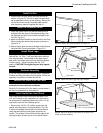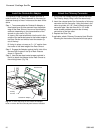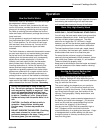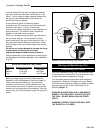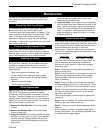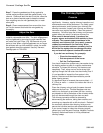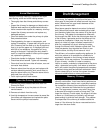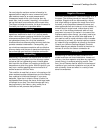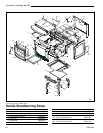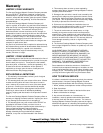
21
Vermont Castings Seville
30001490
Let the fire in the stove go out and allow the stove to
cool completely before beginning any maintenance
procedure.
Care of the Cast Iron Surface
An occasional dusting with a dry rag will keep the
painted cast iron of your Seville looking new.
The stove’s paint can be touched up as needed. First,
clean the areas to be painted with a wire brush. Then,
touch up the stove with Vermont Castings high
temperature stove paint. Apply the paint sparingly,
and keep in mind that two light coats of paint are better
than a single heavy one.
Care of Porcelain Enamel Finish
Use a dry or slightly damp rag or a soft brush to
remove spills or stains. For difficult jobs that require a
cleaning agent, use only a kitchen appliance cleaner or
polish recommended for use on enamel surfaces.
Cleaning the Glass
Most of the carbon deposits on the glass will burn off
during hot fires. However, the ash residue that accu-
mulates on the glass surface should be removed
regularly to prevent etching. Follow this procedure to
clean the glass:
• Be sure the glass is completely cool.
• Clean the glass with water or a cleaner made
especially for this purpose. Do not use abrasive
cleaners.
• Rinse the glass thoroughly.
• Dry the glass completely.
Glass Replacement
Replace glass only with Vermont Castings part no.
3000-0774. The glass panel rests on a cushion
provided by three flat gaskets, and is held in place by
two clips. The glass is coated on one side which is
slightly colored. Remove the door from the stove and
place it on a sturdy, level work surface. Use a towel to
protect the porcelain enamel finish.
1. Remove the Door Manifold. (Two phillips head
screws).
2. Remove the Retainer Clips. (Two phillips head
screws on each clip).
3. Inspect the Gasket. If the window gasket is in good
condition, you can leave it in place. If you replace it,
use only Vermont Castings gaskets. Be sure the
channel around the window opening is clean, and
free of dust.
Place the three flat gaskets (two vertical, one
horizontal) into the panel inset.
4. Install the Glass. Lay the glass on the inner gasket
with the coated side down (toward the outside of the
door). Tighten the screws snugly, but loose enough
to allow for a little movement of the glass when the
stove is in operation. Overtightening can crack the
glass immediately or cause it to crack if it is unable
to expand when hot.
Gasket Replacement
Your Seville uses rope-type fiberglass gaskets to make
a tight seal between some parts. With use, particularly
on those parts that move, gaskets can become brittle
and compressed and can begin to lose their
effectiveness. These will need periodic replacement.
The sizes of replaceable gasket are listed below, along
with their applications.
Gasket Size ...And the Parts it Seals
3/8” Fiberglass Door Gasket - 1203589
Wait until the fire is out and the stove has cooled. Be
sure to follow the standard safety procedure for
working with dusty materials: Wear safety goggles
and a dust mask.
Step 1. Remove the existing gasket by grasping an
end and pulling firmly.
Step 2. Use a wire brush or a screwdriver to clean the
channel of any remaining cement or bits of gasket.
Remove stubborn deposits of cement with a cold
chisel if necessary.
Step 3. Determine the correct length of the appropri-
ate-sized gasket by laying it out in the channel. Allow
an extra 1-2" (25-51mm), and mark the spot to be cut.
Step 4. Remove the gasket from the channel, place it
on a wood cutting surface, and cut it at the marked
spot with a utility knife.
Twist the ends slightly to discourage the gasket from
unraveling.
Step 5. Lay an unbroken 1/8" (3mm) bead of gasket
cement in the newly-cleaned channel.
Step 6. Starting at one end, press the gasket into the
channel.
Ensure a good joint where the gasket meets before
trimming any excess. Do not overlap the gasket ends
or leave ends with ragged edges.
Maintenance





